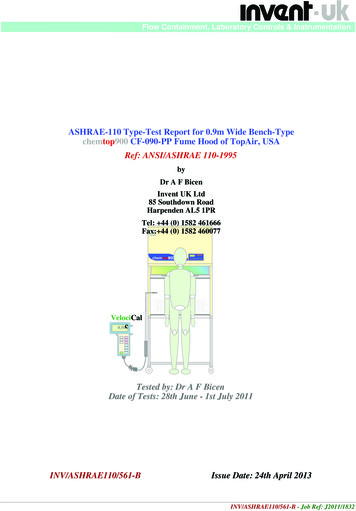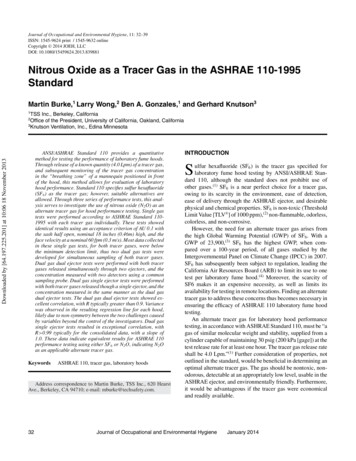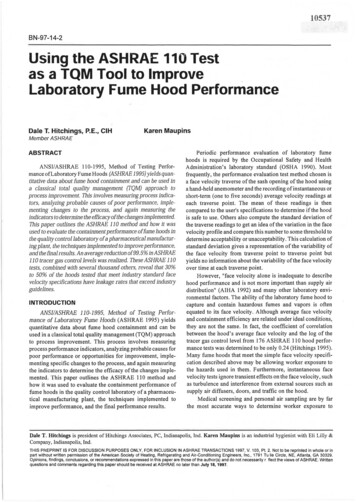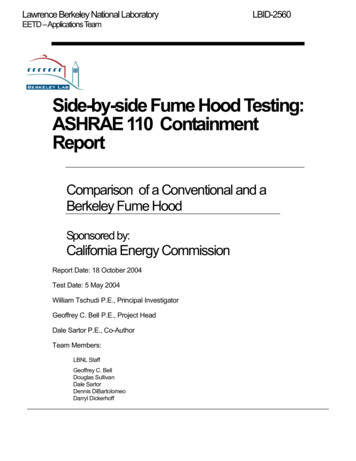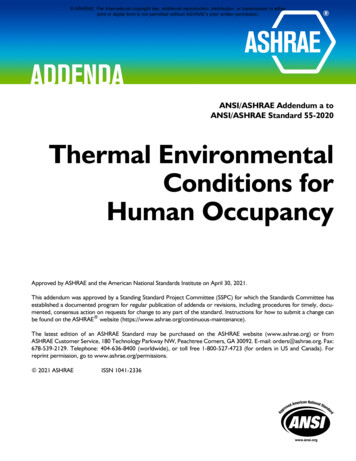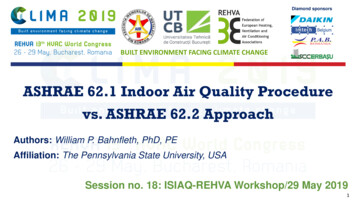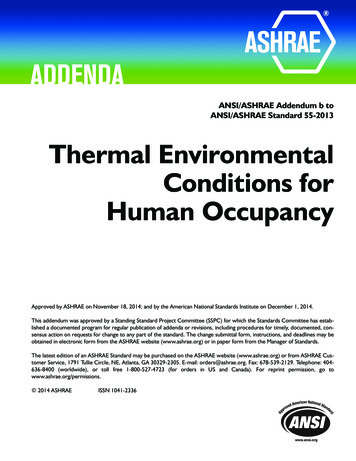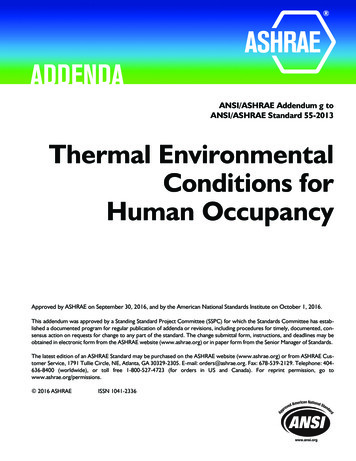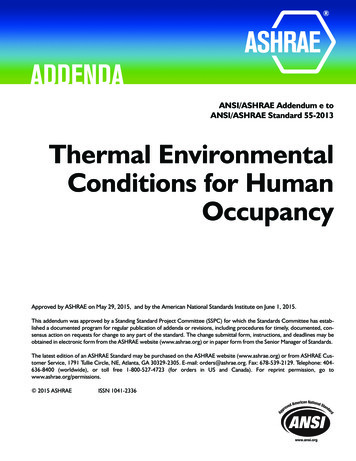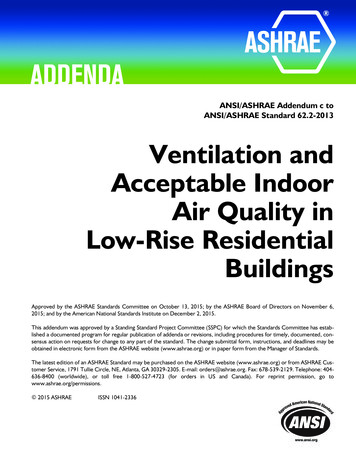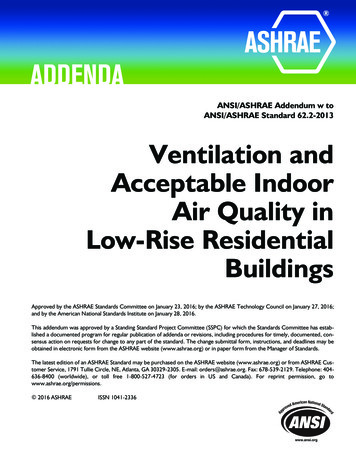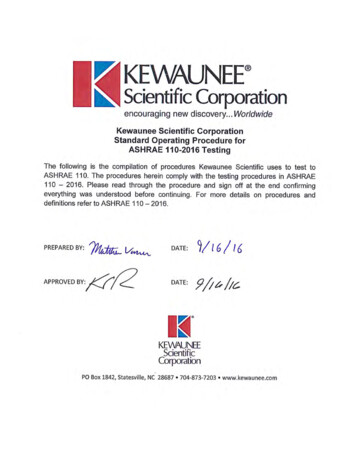
Transcription
ASHRAE 110‐2016DOCUMENT NUMBER: PD‐16‐001DATE: September 9, 2016 : REV: 1Page 2 of 19Table of Contents:1. Purpose42. Scope42.1. Setting of Laboratory Conditions42.2. Face Velocity Measurements52.2. Face Velocity Measurements52.3. Flow Visualization52.4 Tracer Gas Test52.5 Sash Movement Containment Test53. Definitions and Abbreviations63.1 Definitions63.2 Abbreviations84. Associated Equipment and Materials94.1. Air Flow Measurement94.1.1. Face Velocity Measurement Instrument94.2 Air Flow Visualization94.2.1. Local Visualization94.2.2. Large Volume Visualization Challenge94.3. Tracer Gas Test104.3.1. Tracer gas104.3.2. Ejector System104.3.3. Detection Instruments104.3.4. Calibration10
ASHRAE 110‐2016DOCUMENT NUMBER: PD‐16‐001DATE: September 9, 2016 : REV: 1Page 3 of 194.3.5. Mannequin104.4 Miscellaneous Items105. Procedures115.1 Factory Testing Laboratory115.2 Hood Condition115.3. Face Velocity Measurement Procedure115.4 Flow Visualization Procedure115.4.1 Local Visualization Challenge115.4.2 Large Volume Visualization Challenge125.4.3 Evaluation of Smoke Tests125.5 Tracer Gas Test Procedure125.5.1 Closed Loop Method125.5.2 Tracer Gas Test135.6 Sash Movement Containment Test136. Results136.1 Reports137. References14Figure 115Figure 216Figure 317Table118
ASHRAE 110‐2016DOCUMENT NUMBER: PD‐16‐001DATE: September 9, 2016 : REV: 1Page 4 of 191. PurposeThe purpose of this document is to give a better understanding of the degree to whichhoods are tested and how ASHRAE testing procedures are carried out. These procedureswere derived from those stated in the ANSI/ASHRAE 110-2016 Standard “Methods ofTesting Performance Laboratory Fume Hoods” to provide a quantitative and qualitativetest method to gauge a laboratory fume hood’s level of containment.2. ScopeThis test procedure is designed to provide users with a tool to test the functionality andperformance of laboratory fume hood. As such, it is also a valuable tool that is used in thedesign of every fume hood. This procedure holds within it the ASHRAE 110 testingprocedures Kewaunee Scientific applies to the fume hoods it produces. These are justthe testing procedures and do not set any pass/fail criteria. The procedures andperformance criteria are subject to be modified depending on the desires of the customer.As defined by SEFA1 “a laboratory Fume Hood is a safety device specifically designed tocarry undesirable effluents (generated within the hood during a laboratory procedure)away from laboratory personnel and out of the building, when connected to a properlydesigned laboratory ventilation system.” The hood specifications should be set up in sucha way that concentrations of gasses inside of fume hoods are never to exceed explosiveor exposure limits. It is the recommendation of Kewaunee Scientific that facilityDepartments of Health and Safety be aware of the chemicals being used or generated ina laboratory fume hood and that they ensure proper safety routines are in place to preventthese limits from being reached. The procedures in this document are excellent templatesfor safety checks that can be integrated into facility safety routines.These procedures provide a means to effectively gauge the performance of fume hoodsby means of observation and experimentation. The procedures include what data shouldbe reported and the specifications that generated this data. This procedure is designedfor factory testing but may also serve as a guide to evaluate fume hoods installed in thefield.2.1. Setting of Laboratory ConditionsThe Fume Hood Test Room has three exhaust fans and one supply fan. Exhaust fansshould be set in such a way as to provide adequate exhaust to the fume hood so thedesired face velocity is reached. The supply fan should be set below the total exhaust sothat the room is held under slight negative pressure.
ASHRAE 110‐2016DOCUMENT NUMBER: PD‐16‐001DATE: September 9, 2016 : REV: 1Page 5 of 192.2. Face Velocity MeasurementsSash openings for the fume hood being tested are set to operating height as defined bythe end user. Face velocity is measured in a grid pattern to determine an average facevelocity, as well as, observe the uniform air flow through the plane of the sash.2.3. Flow VisualizationThe smoke challenge is executed in two ways; the local challenge and the large volumechallenge. The local challenge demonstrates the flow around the opening of and justinside the hood. The large volume challenge demonstrates the air patterns inside thehood. Observations from the demonstrations are used to evaluate the performance of thefume hood.2.4 Tracer Gas TestThe Tracer Gas Test is the ultimate test for the containment of a fume hood. The testsimulates a lab technician using a fume hood. The test uses a mannequin to representthe lab technician and a probe is placed in what would be the technicians breathing zone.The probe runs to an analyzer that logs the tracer gas concentration while testing. Thetracer gas flows through an ejector at a set rate. The performance of the hood is reportedbased on the results of the test.2.5 Sash Movement Containment TestOpening and closing a sash creates a situation that could cause a contaminant to escapefrom the hood. The Sash Movement Containment Test is used to quantify the results ofopening or closing a sash.3. Definitions and Abbreviations3.1 DefinitionsThis section contains terms how they are defined in ASHRAE 110-20162ASHRAE 110: ASHRAE 110-2016 "Methods of Testing Performance of Laboratory FumeHoods" is a sequence of testing procedures developed by the American Society ofHeating, Refrigerating and Air-Conditioning Engineers, Inc. (ASHRAE) for gauging theperformance of laboratory fume hoods. While testing procedures are specifically for fumehoods they may be adapted for other types of enclosures.
ASHRAE 110‐2016DOCUMENT NUMBER: PD‐16‐001DATE: September 9, 2016 : REV: 1Page 6 of 19Air Supply Fixture: devices or openings through which air flows into the laboratory room(e.g. Grille, Diffuser, Perforated Ceiling, Register).Auxiliary Air: unconditioned or partially conditioned supply or supplemental air deliveredto a laboratory at the laboratory fume hood to reduce room air consumption.Control Level: The average measured concentration of tracer gas, in parts of tracer gasper million of parts of air by volume (ppm), that is not exceeded at the hood face with a4.0 Lpm release rate.Design Opening: the position of the sash at which the design team assumes that the hoodwill be operation. The design opening is critical for determining the volumetric flow throughthe laboratory hood.Face Velocity: the average velocity of air moving perpendicular to the hood face, usuallyexpressed in feet per minute (fpm) or meters per second (m/s).Fume Hood System: an arrangement consisting of a fume hood, its adjacent roomenvironment, and the air exhaust equipment, such as blowers and ductwork, required tomake the hood operableHood Face: the plane of minimum area at the front portion of a laboratory fume hoodthrough which air enters when the sash is or sashes are full opened, usually in the sameplane as the sash for a hood with a vertical sash. For hoods with horizontal sashes,combinations sashes, or multiple vertical sashes, the hood face is the planecorresponding to the surface of the outer-most sash panel.Laboratory Fume Hood (sometimes referred to as a fume cupboard): a box-like structureenclosing a source of potential air contamination, with one open or partially open side,into which air is moved for the purpose of containing and exhausting air contaminants.Lazy Airflow: an airflow problem in a hood that is revealed when the smoke generated ina smoke challenge remains on the work surface without smoothly flowing to the backbaffle.Maximum Opening: the position of the sash at which the hood has the largest opening.Operating Opening: the position of the sash at which the hood user places the sash whileworking at the face of the hood.Performance Rating: a rating designated by a series of letters and numbers consisting ofthe letters AM, AI, or AU and a two- or three-digit number:
ASHRAE 110‐2016DOCUMENT NUMBER: PD‐16‐001DATE: September 9, 2016 : REV: 1Page 7 of 19AM yyyAI yyyAU yyyWhere:AM identifies an “as manufactured” test, that is, the laboratory hood is built andassembled by the manufacturer and testing is performed at the factory.AI identifies and “as installed” test, that is, the laboratory hood is installed at thelocation of the customer. The hood is tested empty, but with the ventilation systemin the installation balanced and the hood in its final location.AU identifies and “as used” test, that is, the test is conducted after the hood hasbeen installed and used by the chemist. The typical equipment remains in the hoodand other activities in the laboratory continue.yyy is the control level of tracer gas established by the test in ppm.Positional control level: the average tracer gas concentration at a position during a test.Release Rate: the rate of release, in actual liters per minute (Lpm), of tracer gas during ahood test.Reverse flow: an airflow problem in the hood that is revealed when the smoke releasedin the hood moves forward toward the front of the hood. The term does not apply to theforward motion of the roll inside the hood that occurs in the upper cavity of the hood abovethe hood opening or to the cyclonic motion that occurs behind a closed horizontal sash.Roll: the rotation of air behind the sash or in the upper cavity of the hood.Sash Movement Effect: the maximum 45-second rolling average of the tracer gasconcentration observed during a series of sash movement tests at the center of the hoodopening.Sash Movement Performance Rating: a rating designated by a series of letters andnumbers consisting of the letters SME-AM, SME-AI, or SME-AU and a two- or three-digitnumber:
ASHRAE 110‐2016DOCUMENT NUMBER: PD‐16‐001DATE: September 9, 2016 : REV: 1Page 8 of 19SME-AM yyySME-AI yyySME-AU yyyWhere:SME means “sash movement effect”AM means “as manufactured”AI means “as installed”AU means “as used”yyy is the sash movement effect in ppm.Specified Rating: the hood performance rating as specified, proposed, or guaranteedeither in the purchase of the hood or in the design and construction of the laboratory, orboth.Test Opening: the position or positions of the sash(es) at which the hood is to be tested.Titanium Tetrachloride: a chemical, TiCl4, used to generate the white visible fumesrequired for preliminary testing in laboratory hoods.3.2 AbbreviationsLpmliters per minuteppmparts of tracer gas per million parts of air by volumefpmfeet per minutecfmcubic feet per minutem/smeters per second4. Associated Equipment and MaterialsStandard equipment used by Kewaunee during ASHRAE 110 testing consists of:
ASHRAE 110‐2016DOCUMENT NUMBER: PD‐16‐001DATE: September 9, 2016 : REV: 1Page 9 of 19a)b)c)d)e)f)g)TSI Velocicalc Air Velocity Meter – Figure 2MSA Ventilation Smoke Tube Kit (P/N 458481)LabHoodPro Fog Generator (Model SG-301) and associate fogging columnsMiran 103 Vapor Analyzer – Figure 3Pico Data Logger – Figure 3Tracer Gas Ejector – Figure 3Mannequin4.1. Air Flow Measurement4.1.1. Face Velocity Measurement Instrument:Velocity readings shall be taken from a calibrated anemometer. The anemometer shallbe capable of measuring in a range of 30 fpm to 400 fpm with an accuracy of 3% or 3 fpm, whichever is greater.4.2 Air Flow Visualization4.2.1. Local Visualization:A source of observable smoke shall be present to generate small controlled volumesinside the fume hood. Recommended smoke sources consist of ventilation smoke tubesor smoke sticks, as manufactured by MSA, or smaller capacity fog generators such asthe Zero Wizard Stick. The composition of some smoke generated should be kept in mindas they could potentially be corrosive or hazardous, such as titanium tetrachloride. It isalways advised that users be aware of the hazards these devices may cause.4.2.2. Large Volume Visualization Challenge:A source of observable smoke shall be available to generate a large volume of smoke inthe fume hood. Recommended smoke sources include smoke candles or theatrical foggenerators. It is important that the apparatus generating the smoke does not produce anair velocity high enough that it affects the airflow pattern inside the hood.4.3. Tracer Gas Test4.3.1. Tracer gas:
ASHRAE 110‐2016DOCUMENT NUMBER: PD‐16‐001DATE: September 9, 2016 : REV: 1Page 10 of 19The tracer gas tracer gas used for testing shall be chemically pure sulfur hexafluoride,SF6. The cylinder shall be capable of maintaining 30 psig at a release rate of at least 4Lpm for 30 minutes.4.3.2. Ejector System:The ejector for the tracer gas will follow specifications provided in the ASHRAE 110.4.3.3. Detection Instruments:The detector instrument shall be a continuous reading instrument set up for the tracergas. A minimum detection range of 0.01 to 20 ppm is required. The instrument will beaccurate to 10% of the reading or 0.025, whichever is greater. The instrument will havethe ability to log data digitally.4.3.4. Calibration:The detector shall be calibrated with a known concentration of SF6 no more than 24 hoursbefore and immediately after testing.4.3.5. Mannequin:The mannequin shall be a three dimensional mannequin that accurately portrays humanproportions. The mannequin will be clothed in a smock, coveralls, or clothing typical tothat worn in a laboratory setting.4.4 Miscellaneous ItemsVarious equipment, such as measuring tape, extension cords, small wrenches, ornotepads, shall be used as necessary.5. Procedures5.1 Factory Testing Laboratory (Figure 1)
ASHRAE 110‐2016DOCUMENT NUMBER: PD‐16‐001DATE: September 9, 2016 : REV: 1Page 11 of 19a) The test lab shall be balanced to give the amount of exhaust needed to the fumehood at the required specifications. The supply shall be set so that it is slightly lessthan the exhaust, to put the room under negative pressure. The room will be ableto m
ASHRAE 110: ASHRAE 110-2016 "Methods of Testing Performance of Laboratory Fume Hoods" is a sequence of testing procedures developed by the American Society of Heating, Refrigerating and Air-Conditioning Engineers, Inc. (ASHRAE) for gauging the performance of laboratory fume hoods. While testing procedures are specifically for fume hoods they may be adapted for other types of enclosures. ASHRAE .File Size: 385KBPage Count: 19
